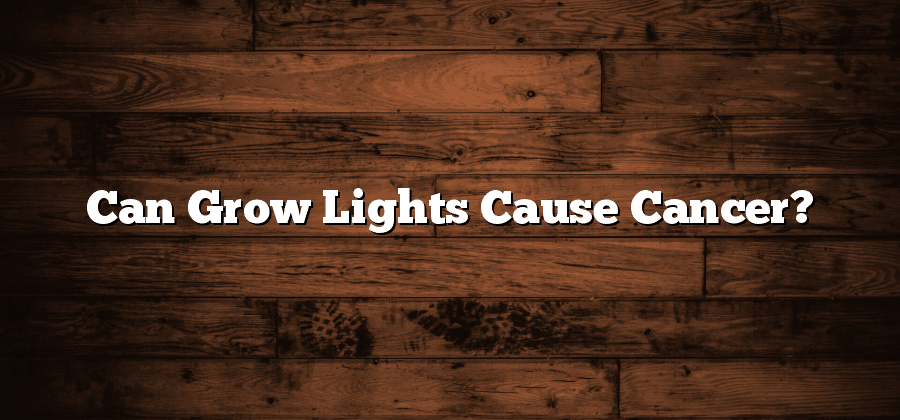Understanding the Effects of Grow Lights
Grow lights have revolutionized the way plants are grown indoors. With their ability to provide artificial light that mimics the spectrum of natural sunlight, these lights have become an essential tool for horticulturists and indoor gardeners. By understanding the effects of grow lights, one can optimize plant growth, enhance photosynthesis, and ultimately increase crop yield.
One of the primary effects of grow lights is their ability to stimulate photosynthesis in plants. Photosynthesis is the process by which plants convert light energy into chemical energy, enabling them to produce their own food. Grow lights, particularly those that emit blue and red wavelengths, provide the necessary light spectrum for photosynthesis to occur efficiently. This means that plants receive the energy they need to grow and thrive, even in low-light or indoor environments where natural sunlight may be limited. Additionally, with the right combination of wavelengths, grow lights can also influence other aspects of plant development, such as flowering and fruiting.
The Connection Between Light and Cancer
Light has long been known to play a crucial role in various biological processes, including regulating our sleep-wake cycle and influencing our mood. However, recent research has shed light on the potential connection between light exposure and cancer. While the exact mechanisms are still being investigated, several studies have observed a possible link between certain types of light and an increased risk of developing cancer.
One area of concern is the use of artificial light sources, such as grow lights, which emit high levels of blue light. Blue light has a shorter wavelength and higher energy compared to other colors in the light spectrum. Studies have suggested that prolonged exposure to blue light, especially at night, can disrupt the body’s natural circadian rhythm and suppress the production of melatonin, a hormone that plays a crucial role in regulating sleep and has been found to have anti-cancer properties. This disruption in the circadian rhythm and melatonin suppression may contribute to an increased risk of cancer development. However, further research is needed to fully comprehend the complex relationship between light exposure and cancer, and to determine the specific mechanisms involved.
Examining the Spectrum of Grow Lights
Grow lights are a crucial tool in indoor gardening and agriculture, providing artificial light to support plant growth. The spectrum of light emitted by grow lights plays a significant role in plant development and health. Different types of grow lights emit varying spectrums, each with its unique advantages and considerations.
One commonly used type of grow light is fluorescent lights. These lights emit a broad spectrum of light, including both blue and red wavelengths. Blue light promotes vegetative growth, influencing leaf development and overall plant structure. Red light, on the other hand, stimulates flowering and fruiting. While fluorescent lights provide a good balance of wavelengths for general plant growth, they are less efficient and produce less intense light compared to other options.
Research Findings on the Relationship
Recent research studies have focused on examining the potential relationship between exposure to certain types of grow lights and the risk of cancer. These studies have sought to determine if there is a direct connection between the two and if specific factors, such as the spectrum of the grow lights or the duration of exposure, play a role. The findings of these studies are crucial in understanding the potential risks associated with grow light usage and in formulating strategies to mitigate any adverse effects on human health.
One of the key research findings suggests that there is indeed a relationship between certain types of grow lights and an increased risk of cancer. For example, studies have shown that exposure to high levels of ultraviolet (UV) radiation, which is often emitted by some types of grow lights, can damage DNA and increase the likelihood of developing skin cancer. These findings highlight the importance of considering the spectrum of grow lights used in indoor gardening setups and implementing measures to minimize or filter out any harmful UV radiation. Furthermore, research also indicates that the duration of exposure to grow lights may play a significant role in determining the risk of cancer, emphasizing the need for understanding optimal exposure times and guidelines.
The Role of UV Radiation in Cancer Risk
UV radiation, which is part of the electromagnetic spectrum, has long been recognized as a risk factor for the development of skin cancer. It is well-established that exposure to UV radiation can cause DNA damage in the skin cells, leading to genetic mutations that can eventually result in the formation of cancerous tumors. The amount of UV radiation that reaches our skin depends on various factors, including the time of day, the season, and the geographical location.
In recent years, research has also suggested a potential link between UV radiation and certain types of internal cancers, such as lung, breast, and colon cancer. While the mechanisms underlying this association are not yet fully understood, it is thought that UV radiation may indirectly influence the development of these cancers through its effects on the immune system or by promoting the production of reactive oxygen species, which can damage cellular DNA. However, further studies are needed to determine the exact role of UV radiation in the development of these internal cancers.
Overall, the role of UV radiation in cancer risk is a complex and multifaceted topic that requires ongoing research and investigation. As such, it is crucial for individuals to take appropriate measures to protect themselves from excessive UV exposure, such as wearing protective clothing, using sunscreen, and seeking shade during peak sunlight hours. By understanding and respecting the potential risks associated with UV radiation, we can work towards minimizing the impact of this environmental factor on cancer development.






